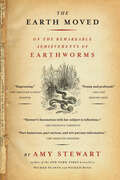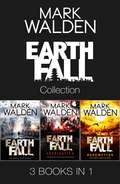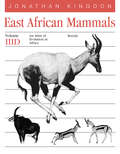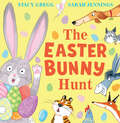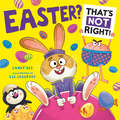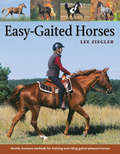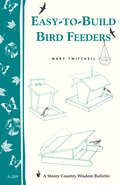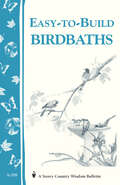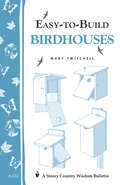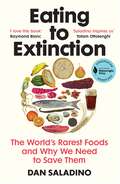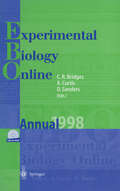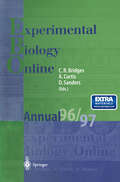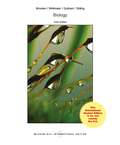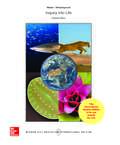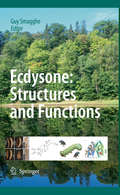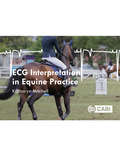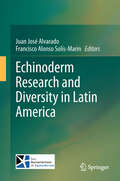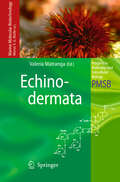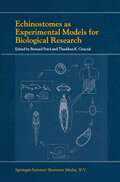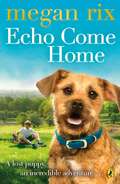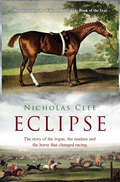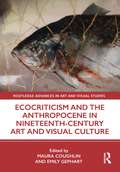- Table View
- List View
The Earth Moved: On the Remarkable Achievements of Earthworms
by Amy Stewart"You know a book is good when you actually welcome one of those howling days of wind and sleet that makes going out next to impossible." —The New York Times In The Earth Moved, Amy Stewart takes us on a journey through the underground world and introduces us to one of its most amazing denizens. The earthworm may be small, spineless, and blind, but its impact on the ecosystem is profound. It ploughs the soil, fights plant diseases, cleans up pollution, and turns ordinary dirt into fertile land. Who knew? In her witty, offbeat style, Stewart shows that much depends on the actions of the lowly worm. Charles Darwin devoted his last years to the meticulous study of these creatures, praising their remarkable abilities. With the august scientist as her inspiration, Stewart investigates the worm's subterranean realm, talks to oligochaetologists—the unsung heroes of earthworm science—who have devoted their lives to unearthing the complex life beneath our feet, and observes the thousands of worms in her own garden. From the legendary giant Australian worm that stretches to ten feet in length to the modest nightcrawler that wormed its way into the heart of Darwin's last book to the energetic red wigglers in Stewart's compost bin, The Earth Moved gives worms their due and exposes their hidden and extraordinary universe. This book is for all of us who appreciate Mother Nature's creatures, no matter how humble.
Earthfall eBook Bundle: A 3 Book Bundle
by Mark WaldenSam wakes to see strange vessels gathered in the skies around London. As he stares up, people stream past, walking silently towards the enormous ships which emit a persistent noise. Only Sam seems immune to the signal.Six months later, Sam is absolutely alone. In five minutes Sam learns two things: he is not alone; the drone injury should have killed him instantly - yet he is still alive. The battle for earth is about to begin.This eBook bundle includes:EarthfallEarthfall: RetributionEarthfall: Redemption
Earthworm (Large Print)
This is a picture of an earthworm viewed from above. There is a locator dot shown, which will be at the top left of the page when the image is the right way up. Just down the page, there is a silhouette of the worm at approximately real size. At the left, in the middle of the page, is the worm's head. Its long body, made of many segments, curves around to its tail on the right of the page.
Earthworm (UEB Contracted)
This is a picture of an earthworm viewed from above. There is a locator dot shown, which will be at the top left of the page when the image is the right way up. Just down the page, there is a silhouette of the worm at approximately real size. At the left, in the middle of the page, is the worm's head. Its long body, made of many segments, curves around to its tail on the right of the page.
Earthworm (UEB uncontracted)
This is a picture of an earthworm viewed from above. There is a locator dot shown, which will be at the top left of the page when the image is the right way up. Just down the page, there is a silhouette of the worm at approximately real size. At the left, in the middle of the page, is the worm's head. Its long body, made of many segments, curves around to its tail on the right of the page.
East African Mammals: An Atlas of Evolution in Africa, Volume 3, Part D: Bovids (East African Mammals #7)
by Jonathan KingdonKingdon's remarkable seven-volume masterwork on East African mammals concludes with two volumes on the bovids, placing them in a broad comparative, ecological, and evolutionary context. Volume IIIC covers cattle, water buffalo, kudus, elands, dwarf antelopes, duikers, reedbucks, and waterbucks; IIID covers gazelles, impalas, wildebeests, oryxes, sheep, and goats. In addition to the stunning, lifelike drawings that are an integral part of the text, the volumes include a reappraisal of bovid taxonomy and original analyses of the form and function of body shape and size, horn shape, coat pattern, and tooth structure.
The Easter Bunny Hunt
by Stacy GreggKnock-knock! Who’s at the door? Join Cat and Dog as they await the arrival of one special Easter visitor in this hilarious illustrated picture book.
Easter? That’s Not Right!
by Candy BeeIt’s Easter with a twist in this hilarious mix-up of eggs with legs and hot cross BUMS…
Easy-Gaited Horses: Gentle, humane methods for training and riding gaited pleasure horses
by Lee ZieglerEnjoy a comfortable long-distance ride on a well-trained gaited horse and you&’ll be surprised at how easygoing these handsome animals can be. But unique challenges can arise when horse owners more familiar with the standard walk, trot, and canter try to train these complex and multigeared horses to gait correctly. Author Lee Ziegler guides riders through the finer points of developing and maintaining these extra gaits, using humane training methods that stress patience and good horsemanship.
Easy-to-Build Bird Feeders: Storey's Country Wisdom Bulletin A-209 (Storey Country Wisdom Bulletin)
by Mary TwitchellSince 1973, Storey's Country Wisdom Bulletins have offered practical, hands-on instructions designed to help readers master dozens of country living skills quickly and easily. There are now more than 170 titles in this series, and their remarkable popularity reflects the common desire of country and city dwellers alike to cultivate personal independence in everyday life.
Easy-to-Build Birdbaths: Storey's Country Wisdom Bulletin A-208 (Storey Country Wisdom Bulletin)
by Mary TwitchellSince 1973, Storey's Country Wisdom Bulletins have offered practical, hands-on instructions designed to help readers master dozens of country living skills quickly and easily. There are now more than 170 titles in this series, and their remarkable popularity reflects the common desire of country and city dwellers alike to cultivate personal independence in everyday life.
Easy-to-Build Birdhouses: Storey's Country Wisdom Bulletin A-212 (Storey Country Wisdom Bulletin)
by Mary TwitchellSince 1973, Storey's Country Wisdom Bulletins have offered practical, hands-on instructions designed to help readers master dozens of country living skills quickly and easily. There are now more than 170 titles in this series, and their remarkable popularity reflects the common desire of country and city dwellers alike to cultivate personal independence in everyday life.
Eating to Extinction: The World’s Rarest Foods and Why We Need to Save Them
by Dan Saladino'This inspiring and urgent book is one of the few food books that has ever given me goosebumps... A story full of both loss and hope.' BEE WILSON'We all need to pay more attention to what we are (and are no longer) eating. Dan Saladino inspires us to believe that turning the tide is still possible.' YOTAM OTTOLENGHI'I love this book... I wish the whole world could read it' RAYMOND BLANC--------------From a tiny crimson pear in the west of England to great chunks of fermented sheep meat in the Faroe Islands, from pistachios in Syria to flat oysters in Denmark, from a wild honey harvested with the help of birds to an exploding corn that might just hold the key to the future of food - these are just some of the thousands of foods around the world today that are at risk of being lost for ever. In this captivating and wide-ranging book, Dan Saladino spans the globe to uncover the stories of these foods. He meets the pioneering farmers, scientists, cooks, food producers and indigenous communities who are preserving food traditions and fighting for change. All human history is woven through these stories, from the first great migrations to the slave trade to the refugee crisis today. But Eating to Extinction is about so much more than preserving the past. It reveals a world at a crisis point: the future of our planet depends on reclaiming genetic biodiversity before it is too late. Eating to Extinction is an astonishing journey through the past, present and future of food, a love letter to the diversity of global food cultures, and a work of great urgency and hope.
EBO: Experimental Biology Online Annual 1998 (EBO - Experimental Biology Online Annual #1998)
by Christopher R. Bridges Dale Sanders Adam CurtisThough it is a pleasure to write a short foreword to this collection of excellent scientific papers covering a range of biological topics, the rather depressing feature is the small number of papers. All-electronic publishing is developing and your Editors do have great faith in it. One problem for potential authors has been the reluctance of the abstracting journals to pay any attention to electronic journals - perhaps Springer should make a rapid move in this area and start the first all-electronic journal abstracting this type of literature. However, even the paper citation journals are starting to pay attention to the medium. The particular advantages of all-electronic publishing are beginning to emerge more clearly and it is clear that publishing video material is a unique advantage of our format. Several papers took advantage of this - for example those by Riehle and others on cell behaviour in tunnels, by Bereiter-Hahn and Voss on zonation in the plasmalemma and by Pavlikova, Zicha, Chaloupkova and Vesely on cell motility of tumour cells. These papers made essential and extensive use of video material, publishing some material of great originality. The work on cell pola rity and calcium ions in Fucus embryos by Brownlee, Manison and Anning used animation to present their results in an especially clear way. The facility of use of animation is another special advantage of our type of publication that should be more widely used.
EBO — Experimental Biology Online Annual 1996/97 (EBO - Experimental Biology Online Annual #1996/1997)
by Christopher R. Bridges Adam Curtis Dale SandersIn March 1996 the Society of Experimental Biology (UK) together with two other international scientific societies, the Australian and New Zealand Society for Comparative Physiology and Biochemistry and the Society for Integrative and Comparative Biology (formally the American Society for Zoology) joined forces with Springer-Verlag, Heidelberg to produce one of the first fully electronic online, peer-reviewed biological journals, Experimental Biology Online. The present product represents the fruits of this joint venture and encapsulates Volumes 1 and 2 of the journal. This will be an ongoing series such that an archival version of the journal will be available to all libraries as well as the on-line version. At the outset this was "new land" for all concerned but the launching of a journal which would cover experimental biology in terms of Animal, Cell and Plant topics was daunting but we all felt that the use of electronic media and the internet would be ideally suited to this purpose.
Ebook: Inquiry into Life (UK Higher Education Science & Technology Bioscience)
by Mader WindelspEbook: Inquiry into Life
Ecdysone: Structures and Functions
by Guy SmaggheEcdysone is the steroidal prohormone of the major insect moulting hormone 20-hydroxyecdysone. It groups with its homologues the steroidal molting hormones in arthropods, but they also occur in other phyla where they can play different roles. Besides ecdysteroids appear in many plants mostly as protection agents (toxins or antifeedants) against herbivorous insects. The important developments and achievements in modern ecdysone science since the first edition in 1989 by J. Koolman have led to this new revised, expanded and retitled reference work. New chapters in this edition include RNA interference, the ecdysone receptor crystal structures and structure activity relationships, etc. Each article may also be read independently, as a review of that particular subject. Complete up-to-date coverage of many important topics - the book is divisible into five conceptual areas: (1) Distribution and diversity of ecdysteroids in the two kingdoms is still basis, (2) In the post-genomic era, ecdysteroid genetic hierarchies in insect growth and reproduction, (3) Role of cross talk of genes and growth factors in ecdysteroid titers and signaling, (4) Ecdysteroids function through nuclear and membrane receptors, and (5) Ecdysteroids in modern agriculture, medicine, doping and ecotoxicology. Each of the 23 chapters is written by scientists active in the reviewed research area and a truly distinguished international team of contributors has been chosen. Ecdysone, Structures and Functions will be of immense use and contains essential information for scientists, students, and professionals alike in entomology, endocrinology, physiology, chemistry, and agricultural, plant, biomedicine and environmental sciences.
ECG Interpretation in Equine Practice
by Katharyn MitchellAdvances in veterinary medical technology now provide easier and more affordable access to equine ECG recording and transmitting equipment, making ECG recordings a useful tool for equine veterinarians in both field and hospital settings. Covering the basics of equine ECG recording, analyses and interpretation, this book provides a practical approach with details of how to get the most information out of your ECG recordings. The only book dedicated to equine ECGs, it includes: - Numerous clear ECG illustrations - Worked case examples to put theory into practice - New pharmacological therapies and interventional techniques A hands-on guide for veterinarians to use when recording, diagnosing and treating arrhythmias in horses, this book will be invaluable to both specialists and those who find themselves evaluating the occasional equine patient.
Echinoderm Research and Diversity in Latin America
by Juan José Alvarado and Francisco Alonso Solís-MarínThis book compiles for the first time the development of echinoderm research in Latin America. The book contains 17 chapters, one introductory, 15 country chapters, and a final biogeographic analysis. It compiles all the investigations published in international and local journals, reports, theses and other gray literature. Each chapter is composed of 7 sections: introduction describes the marine environments, and main oceanographic characteristics, followed by a history of research account divided by specific subjects. The next section addresses patterns of distribution and diversity. A specific section would explain fishery or aquaculture activities. The next sections deal with environmental and anthropogenic threats that are affecting echinoderm, and any conservation or management action. Finally, a section with conclusions, needs and new lines of research. The book will include two appendixes with species lists of all echinoderms with bathimetric data, habitat and distribution.
Echinodermata (Progress in Molecular and Subcellular Biology #39)
by Valeria MatrangaMembers of the phylum Echinodermata are among the most familiar marine invertebrates. Forms such as the sea star have become virtually a symbol of sea life. Used in ancient oriental medicine as a source of bioactive compounds, sea cucumbers, sea stars and sea urchins are now used for the extraction and purification of cytotoxic, haemolytic, antiviral, antifungal, antifouling, antimicrobial and even anti-tumoural activities. In addition, of the five extant classes, sea urchins and sea cucumbers are important economic resources for current fishery and aquaculture. Molecular and cell biological techniques described in this book are, on the one hand, indicative of the improvements made over the years and, on the other, stress the need of their further exploitation for the sustainable production of bioactive compounds and their application in biomedicine.
Echinostomes as Experimental Models for Biological Research
by Bernard Fried T. K. GraczykEchinostomes are ubiquitous intestinal flatworm parasites of vertebrates and are of importance in human and veterinary medicine and wildlife diseases. Echinostomes can be maintained easily and inexpensively in the laboratory and provide good models for biological research ranging from the molecular to the organismal. Considerable but scattered literature has been published on the subject of echinostomes and a synthesis of this wide range of topics has now been achieved with the publication of this book, which presents a wide range of topics in experimental biology related to the use of echinostomes as laboratory models. It will have a special appeal to advanced undergraduates and graduate students in parasitology and should also appeal to professional parasitologists, physicians, veterinarians, wildlife disease biologists, and any biomedical scientists interested in new model systems for studies in experimental biology.
Echo Come Home
by Megan Rix'I wish I had a dog . . . It could be a big dog or a little one. It could be any colour or breed. Just most of all I'd like a hearing dog.'Eleven-year-old Jake is dreading his new school. No one understands how hard it is for him to make friends.But then Jake meets Echo. Echo is a stray puppy, training to be a hearing dog. With Echo by his side, Jake's confidence grows.But then something terrible happens and Jake and Echo are separated. Determined to find his way back to Jake, Echo sets out on the difficult journey home.With a long road ahead and danger all around, have Jake and Echo lost each other forever?
Eclipse: The Story Of The Rogue, The Madam And The Horse That Changed Racing
by Nicholas CleeEpsom Downs, 3rd May, 1769: a chestnut with a white blaze scorches across the turf towards the finishing post. His four rivals are so far behind him that, in racing terms, they are 'nowhere'. Watching Eclipse is the man who wants to buy him. An adventurer who has made his money through roguery and gambling, Dennis O'Kelly is also the companion of the madam of one of London's most notorious brothels. While O'Kelly is destined to remain an outcast to the racing establishment, his horse will go on to become the undisputed, undefeated champion of his sport. Eclipse's male-line descendants will include Desert Orchid, Arkel and all but three of the Derby winners of the past fifty years. And his astonishing life will be matched only by that of the rogue who owned him.
Ecocriticism and the Anthropocene in Nineteenth-Century Art and Visual Culture (Routledge Advances in Art and Visual Studies)
by Maura CoughlinIn this volume, emerging and established scholars bring ethical and political concerns for the environment, nonhuman animals and social justice to the study of nineteenth-century visual culture. They draw their theoretical inspiration from the vitality of emerging critical discourses, such as new materialism, ecofeminism, critical animal studies, food studies, object-oriented ontology and affect theory. This timely volume looks back at the early decades of the Anthropocene to query the agency of visual culture to critique, create and maintain more resilient and biologically diverse local and global ecologies.
